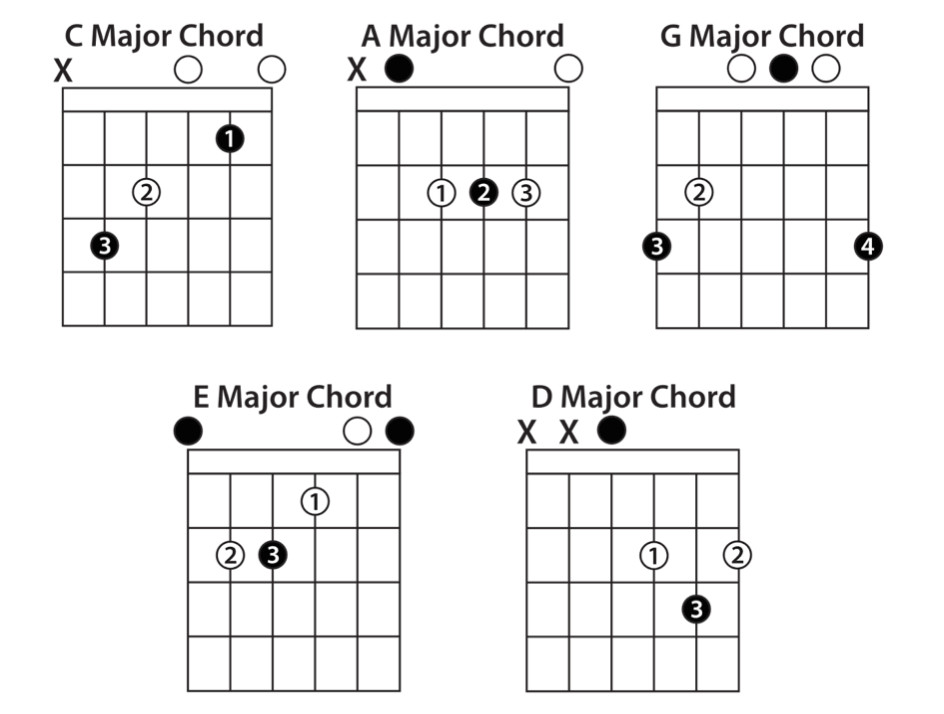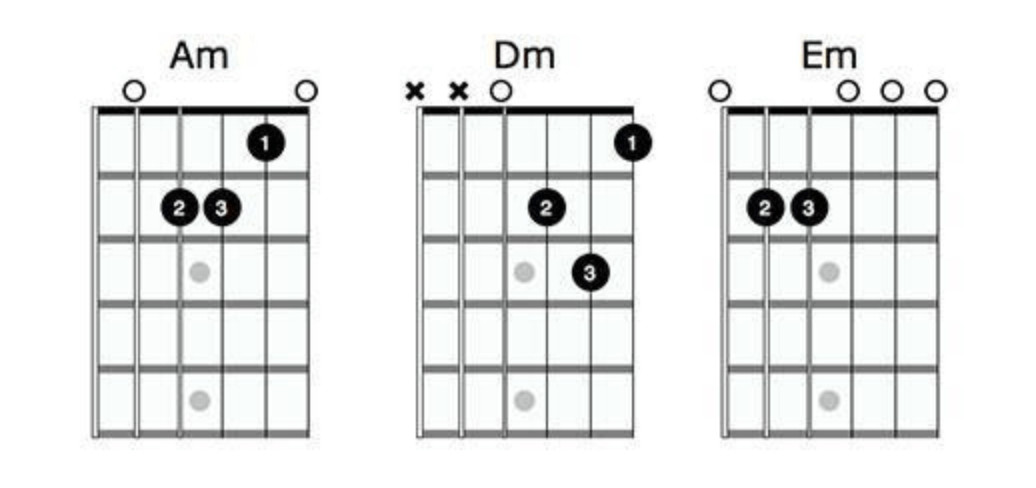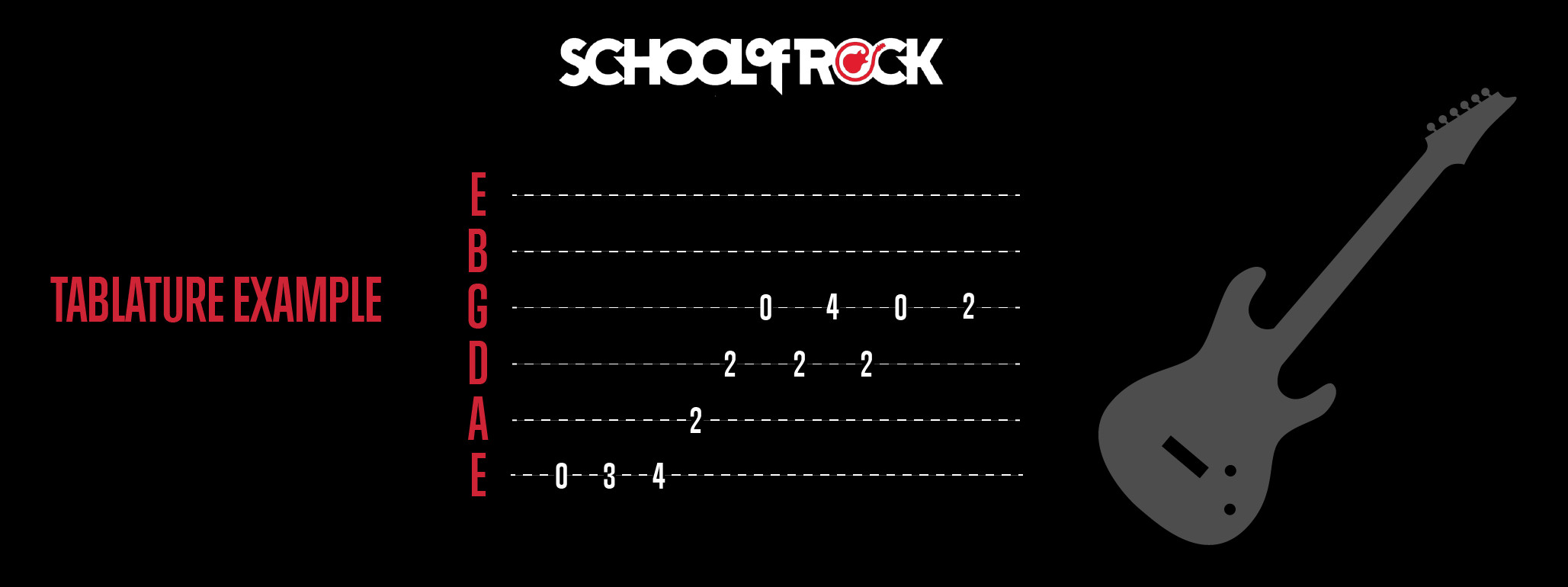Picking up an electric guitar and wanting to dive straight into playing is exciting. But where do you even begin? A fundamental starting point for any guitarist, especially on electric, is learning chords. Electric Guitar Chords are the backbone of countless songs, creating harmony and rhythm. Without them, music would lack depth and feel incomplete. While instruments like drums and bass focus on rhythm and foundational harmony, guitars – particularly electric guitars – excel at delivering rich chords.
Let’s explore the world of electric guitar chords for beginners. We’ll cover different types of chords that are perfect to start with, provide practical tips and tricks to master them, and even suggest songs you can learn to play right away.
At institutions like School of Rock, the teaching philosophy emphasizes hands-on experience. Students immediately apply what they learn in lessons to live performances. This approach highlights the importance of both lead and rhythm guitar skills. While lead guitarists often focus on melodies, riffs, and solos, rhythm guitarists are the masters of chords, employing techniques like strumming and fingerpicking. Regardless of your preferred style, understanding electric guitar chords is absolutely crucial. If you’re considering getting your first electric guitar or upgrading your current one, it’s worth checking out a comprehensive guitar-buying guide for helpful advice.
Understanding Basic Electric Guitar Chords
Learning electric guitar chords can seem daunting initially. There are various types of chords and multiple ways to play them. However, for beginners, focusing on a few key types is the best approach. Generally, electric guitar chords can be categorized into three main types, starting with the easiest:
Power Chords: The Rock Guitar Staple
Power chords are often the very first chords electric guitarists learn, and for good reason. They are incredibly common in rock, metal, punk, and even modern pop music. What makes power chords beginner-friendly? They typically involve only two or three strings and frets, making them physically easier to play. This reduced complexity is especially beneficial when you’re just developing finger strength and coordination on the electric guitar.
Power chords are most prominently used on electric guitars because their sound truly shines when amplified and distorted. While distortion can be applied to any chord, it particularly enhances the raw, driving sound of power chords, giving them a powerful and impactful tone that defines many genres. They are excellent for creating a strong rhythmic foundation and are perfect for rock riffs and heavy rhythms.
Open Chords: Foundation for Melodic Playing
Open chords are another essential type of electric guitar chord for beginners. They are called “open” because they incorporate one or more open strings – strings that are played without being fretted. Like power chords, open chords are relatively easy to learn as they generally use fewer frets and fingers compared to more complex chord types. However, unlike power chords which might use only a few strings, open chords typically utilize all six strings of the electric guitar, creating a fuller, richer sound.
The common open chords are often remembered by the acronym CAGED – C, A, G, E, and D major chords. These form a foundational set of chords that are used in countless songs across various genres. We will delve into these specific CAGED chords and how to play them shortly. Open chords on electric guitar are fantastic for strumming patterns, folk-style playing, and songs where a clear, ringing tone is desired.
Barre Chords: Versatility Across the Fretboard
Barre chords represent a step up in difficulty from power and open chords. They require more finger strength and precision, but they unlock a significant level of versatility on the electric guitar. The key characteristic of barre chords is that one finger (usually the index finger) is used to “bar” or press down multiple strings across a single fret. This barre essentially acts as a movable nut, allowing you to shift the entire chord shape up and down the fretboard to create different chords without changing the finger positions relative to each other.
While initially challenging for beginners due to the finger strength required to press down all the strings cleanly, mastering barre chords is incredibly rewarding. They allow for smooth transitions between chords and provide access to a wider range of chords up and down the neck of the electric guitar. We will explore barre chords in more detail in future guides, but for now, beginners should focus on power and open chords as their foundation.
Exploring Open Electric Guitar Chords: CAGED System
Before diving into specific open electric guitar chords, it’s crucial to ensure your electric guitar is properly tuned. Tuning is the foundation for playing chords that sound correct and in harmony. If you’re unsure about tuning, numerous resources are available online, including this helpful guide: https://www.schoolofrock.com/resources/guitar/beginners-guide-to-tuning-a-guitar. A well-tuned electric guitar will make learning chords much more enjoyable and effective.
Now, let’s examine open chords, particularly the CAGED system, which is a cornerstone of the School of Rock’s teaching methodology. The CAGED system is emphasized because these chords are incredibly versatile and frequently used in a vast repertoire of popular songs that students learn and perform. Each letter in CAGED represents a major open chord: C, A, G, E, and D. Chord diagrams are essential tools for learning these shapes.
 Open Guitar Chords for Beginners
Open Guitar Chords for Beginners
Understanding Chord Diagrams for Electric Guitar
A chord diagram is a visual representation of the electric guitar fretboard, showing you exactly where to place your fingers to play a specific chord. Learning to read chord diagrams is fundamental for any beginner electric guitarist. Here’s how to interpret them:
- Orientation: Chord diagrams are typically read horizontally. The top line represents the thickest string (low E string), and the bottom line is the thinnest string (high E string). Imagine holding your electric guitar upright in front of you – this is the perspective of the diagram.
- Strings and Frets: Vertical lines represent the strings of the electric guitar, and horizontal lines represent the frets.
- X and O Symbols: An “X” above a string indicates a muted string, meaning you should not play that string as part of the chord. An “O” above a string denotes an open string, which means you play that string without fretting any note.
- Numbers: Numbers within the diagram indicate which finger to use on a specific fret. 1 = index finger, 2 = middle finger, 3 = ring finger, and 4 = pinky finger.
- Fret Position: The diagram usually starts at the nut (the beginning of the fretboard). If the chord starts at a higher fret, it will be indicated above the diagram. For example, “1fr” means the diagram starts at the 1st fret; “2fr” means it starts at the 2nd fret, and so on. If there is no indication, it’s assumed to start at the open position or nut.
For example, in the A Major chord diagram, you’ll see that all the fretted notes are on the second fret. The diagram guides you to place your index finger on the 2nd fret of the D string, your middle finger on the 2nd fret of the G string (string below D), and your ring finger on the 2nd fret of the B string (string below G).
 A Major Chord Diagram with Finger Positions
A Major Chord Diagram with Finger Positions
Beyond the CAGED chords, several other open electric guitar chords are commonly used and are relatively easy for beginners to learn. These chords expand your chord vocabulary and allow you to play a wider variety of songs.
 Common Beginner Guitar Chords Diagram
Common Beginner Guitar Chords Diagram
It’s important not to confuse chord diagrams with tablature (TAB). While both are visual aids for guitarists, they represent different information. Tablature is a system used to show which frets and strings to play to perform melodies, riffs, and solos. In tablature, lines represent the guitar strings but are read vertically, with the bottom line being the low E string and the top line the high E string. Numbers on the lines indicate the fret to play on that string. “0” means an open string.
 Guitar Tablature Example
Guitar Tablature Example
Chord diagrams are specifically designed to illustrate chord shapes and finger positions, while tablature focuses on single-note melodies and riffs. Although they look different, understanding both chord diagrams and tablature is beneficial for any electric guitarist.
Chord diagrams are incredibly valuable because they not only show you how to form a chord but also suggest efficient fingerings, making it easier to transition between chords. With consistent practice, these chord shapes and finger placements will become muscle memory, and you’ll be able to play electric guitar chords without constantly referring to diagrams.
Tips for Playing Electric Guitar Chords Cleanly
As you learn these and other electric guitar chords, keep these essential practice tips in mind to develop good technique and clean sound:
- Fret Close to the Fret Wire: On an electric guitar neck, you’ll notice metal bars (fret wires) that divide the frets. Position your fingers just behind these fret wires, closer to the bridge side of the guitar. Fretting in this position requires less pressure and produces a clearer sound. Avoid fretting directly on top of or too far behind the fret wire.
- Use Your Finger Tips: Use the very tips of your fingers to press down on the strings. This allows you to apply focused pressure and avoid accidentally muting adjacent strings. Keep your fingers arched, forming a “C” shape, so that only your fingertips make contact with the strings. This curvature is crucial for preventing unwanted buzzing or muted notes, especially on electric guitars where string spacing can be narrower.
- Play Each String Individually: When learning a new electric guitar chord, strum each string separately after forming the chord shape. This helps you identify if any strings are buzzing or muted. If a string doesn’t ring clearly, adjust your finger position slightly until all notes sound clean and distinct. This troubleshooting step is essential for developing accuracy.
- Practice Fretting and Unfretting: Practice transitioning into and out of chord shapes smoothly. Fret the chord, strum it, then release your fingers, and repeat. You can also hover your fingers just above the fretboard in the chord shape while unfretted, preparing for the next repetition. This “fretting and unfretting” exercise improves finger memory, speed, and overall chord changes on the electric guitar.
Popular Songs to Learn with Electric Guitar Chords
Now that you’ve learned some basic electric guitar chords, including open chords and power chords, it’s time to apply them to playing actual songs! Learning songs is a motivating way to practice and solidify your chord knowledge. Here are some popular songs that are excellent for beginner electric guitarists and utilize the chords we’ve discussed (CAGED and minor chords):
- Sweet Home Alabama by Lynyrd Skynyrd: A classic rock anthem famous for its simple yet catchy chord progression using just C, G, and D major chords. Perfect for practicing basic strumming and chord changes on electric guitar.
- Bad Moon Rising by Creedence Clearwater Revival: This upbeat song in the key of D uses only G, D, and A major chords. Another excellent choice for practicing fundamental chord transitions and rhythm on electric guitar.
- Love Me Do by The Beatles: A foundational Beatles track in the key of G, using G, C, and D major chords. Great for learning basic chord progressions and early Beatles-style rhythm on electric guitar.
- Eleanor Rigby by The Beatles: A more melancholic Beatles tune in E minor, primarily using C major and variations of Em. Introduces minor chords and different voicings within a song context on electric guitar.
- Time Of Your Life by Green Day: In the key of G, this song uses G, C, Cadd9, and D5 power chords. While the original uses a D5 power chord, you can easily substitute a regular D major chord for an easier beginner version. A good introduction to both open chords and power chords on electric guitar.
- Island in the Sun by Weezer: This mellow track uses Em, Am, D, and G chords throughout. The bridge section incorporates power chords, making it a fantastic song to practice both open and power chord types on electric guitar.
- Boulevard of Broken Dreams by Green Day: In F minor, this song uses Em, G, D, and A chords. Towards the end, power chords are used, providing another opportunity to practice transitioning between open and power chords within a song on electric guitar.
More Great Songs for Beginner Electric Guitarists:
- Hey There Delilah by Plain White T’s
- Hallelujah by Leonard Cohen
- Redemption Song by Bob Marley
- Smoke on the Water by Deep Purple (Main riff uses power chords)
- Stairway to Heaven by Led Zeppelin (Intro uses fingerpicked chords, but simplified chord versions exist)
- Hotel California by Eagles (Intro uses more complex chords, but simpler chord versions are playable)
Utilizing Power Chords on Electric Guitar
Power chords, while simpler than open chords in terms of fingerings, share similarities with barre chords in their movable nature. Comparing an A major chord to an A5 power chord illustrates this point. An A major chord contains the notes A, C#, and E. An A5 power chord consists of A and E. The A major chord includes the root, third, and fifth intervals, while the A5 power chord features the root, fifth, and octave (which is the same note as the root, but an octave higher). Essentially, they share a root and fifth, but the power chord omits the third.
This omission of the third interval is crucial: it’s the third that determines if a chord is major or minor. Because power chords lack a third, they are neither definitively major nor minor. This ambiguity makes them incredibly versatile – they can effectively substitute for either major or minor chords in many musical contexts. Experiment and listen for the tonal difference between open chords and power chords as you practice.
Power chords also serve as an excellent stepping stone to learning barre chords. Three-string power chords can be played using a “finger barre” technique, where one finger presses down two strings at the same fret simultaneously. This technique is a simplified version of the full barre chord, helping you develop the finger strength and barre technique needed for more complex chords.
What genres are ideal for practicing electric guitar power chords? Classic rock and much of modern pop music heavily feature power chords. For instance, beginner programs like School of Rock’s Rock 101 often introduce power chords through these genres. Here are some songs to practice:
- Wild Thing by The Troggs: Relies on A5, D5, and E5 power chords, with occasional G5 power chords. A quintessential power chord song, perfect for beginners.
- Let It Be by The Beatles: Interestingly, “Let It Be” can be played with either open chords (C, G, Am, F) or power chords. You can substitute C5, G5, and F5 power chords for their open chord counterparts, demonstrating the versatility of power chords.
- Rock and Roll by Led Zeppelin: Another rock classic built on A5, D5, and E5 power chords. A must-learn for any aspiring electric rock guitarist.
- I Love Rock and Roll by Joan Jett: A definitive power chord anthem using E5, A5, and B5 power chords. Simple, powerful, and iconic.
- When I Come Around by Green Day: This entire song is driven by power chords: F#5, C#5m, D#5, and B5. A great example of power chords in modern rock.
- Rockin’ In the Free World by Neil Young: Starts with power chords (E5, D5, C5) then transitions into a mix of open and power chords (Em, D, C and their power chord versions). Shows how power chords can be used alongside open chords for dynamic effect.
 More Beginner Guitar Chords
More Beginner Guitar Chords
Now that you’ve explored various electric guitar chords for beginners and songs to practice, are you ready to put your new skills to use? Do you need further guidance and structured learning? School of Rock offers both private music lessons and comprehensive music programs designed to get you started on the right path. Programs like Rock 101 and the Performance Program are specifically tailored to help beginner and intermediate players learn to perform full songs as part of a band, applying what they learn in private lessons. These programs foster musical growth through practical experience, teamwork, and valuable life skills. Many of the songs mentioned in this guide are part of these programs, helping students master open and power electric guitar chords while also learning essential music theory. To learn more and begin your electric guitar journey, contact your nearest School of Rock location.
About the Author:
Miranda Morales is a dedicated guitar and keyboard instructor at School of Rock Easton in Pennsylvania, passionate about sharing her musical expertise with aspiring musicians.
